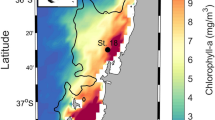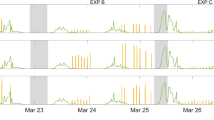Abstract
Toluene is the predominant aromatic compound in freshwater lakes in Central Europe1–3 and sea water4–6. Its concentrations exceed those of the xylene and ethyltoluene isomers both of which also occur in a comparable concentration range. Toluene is also the most important aromatic compound in the air of Europe7, North America8 and Australia9. Anthropogenic sources are held to be responsible for the high concentrations of toluene in water and air. Significant amounts have been introduced by oil spillage, emissions of petrol and diesel fuelled vehicles and other combustion processes10,11. Toluene is therefore often used as a measure of pollution. We report here that while investigating the VOC (volatile organic compounds) in a stratified lake, we found that appreciable amounts of toluene can also be biogenically produced in the anoxic hypolimnion.
This is a preview of subscription content, access via your institution
Access options
Subscribe to this journal
Receive 51 print issues and online access
$199.00 per year
only $3.90 per issue
Buy this article
- Purchase on Springer Link
- Instant access to full article PDF
Prices may be subject to local taxes which are calculated during checkout
Similar content being viewed by others
References
Jüttner, F., Höflacher, B. & Wurster, K. J. Phycol. 22, 169–175 (1986).
Internationale Gewässerschutzkotnmission für den Bodensee Rep. no. 32 (1985).
Jüttner, F. Wat. Sci. Technol. 15, 247–257 (1983).
Gschwend, P. M., Zafiriou, O. C., Mantoura, R. F. C., Schwarzenbach, R. P. & Gagosian, R. B. Envir. Sci. Technol. 16, 31–38 (1982).
Sauer, Jr., T.C. Limnol. Oceanogr. 25, 338–351 (1980).
Gschwend, P., Zafiriou, O. C. & Gagosian, R. B. Limnol. Oceanogr. 25, 1044–1053 (1980).
Bruckmann, P., Beier, R. & Krautscheid, S. Staub-Reinhalt. Luft 43, 404–410 (1983).
Lonnemann, W. A., Sella, R. L. & Bufalini, J. J. Envir. Sci. Technol. 12, 459–463 (1978).
Nelson, P. F. & Quigley, S. M. Envir. Sci. Technol. 16, 650–654 (1982).
Nelson, P. F. & Quigley, S. M. Atmos. Envir. 18, 79–87 (1984).
Dulson, W. Schr. Ver. Wasser, Boden Luft Hyg. 47, 5–128 (1978).
Jüttner, F. Appl. Envir. Microbiol. 47, 814–820 (1984).
Giger, W., Molnar, E. & Schwarzenbach, R. P. Rapports sur les Études et Recherches Entreprises dans le Bassin Lémanique, 62–74 (Com. Int. Protection des Eaux du Léman, 1984).
Pons, J. L., Rimbault, A., Darbord, J. C. & Leluan, G. Annls Microbiol. (Inst. Pasteur) 135B, 219–222 (1984).
Boyd, C. E. Arch. Hydrobiol. 72, 1–9 (1973).
Elsden, S. R., Hilton, M. G. & Waller, J. M. Arch. Microbiol. 107, 283–288 (1976).
Yokoyama, M. T. & Carlson, J. R. Appl. Envir. Microbiol. 41, 71–76 (1981).
Hunt, J. M., Miller, R. J. & Whelan, J. K. Nature 288, 577–578 (1980).
Button, D. K., Robertson, B. R. & Craig, K. S. Appl. Envir. Microbiol. 42, 708–719 (1981).
Williams, P. A. & Worsey, M. J. J. Bact. 125, 818–828 (1976).
Author information
Authors and Affiliations
Rights and permissions
About this article
Cite this article
Jüttner, F., Henatsch, J. Anoxic hypolimnion is a significant source of biogenic toluene. Nature 323, 797–798 (1986). https://doi.org/10.1038/323797a0
Received:
Accepted:
Issue Date:
DOI: https://doi.org/10.1038/323797a0
This article is cited by
-
Anaerobic digestion of toluene-laden wastewater under oxygen-deficient mesophilic condition and concurrent retrieval of methane-enriched biogas
Biomass Conversion and Biorefinery (2023)
-
Microbial production of toluene in oxygen minimum zone waters in the Humboldt Current System off Chile
Scientific Reports (2022)
-
Discovery of enzymes for toluene synthesis from anoxic microbial communities
Nature Chemical Biology (2018)
-
In vitro Characterization of Phenylacetate Decarboxylase, a Novel Enzyme Catalyzing Toluene Biosynthesis in an Anaerobic Microbial Community
Scientific Reports (2016)
-
Coexistence of microbial populations and autostabilization of regulating factors in continuous culture: theory and experiments
Aquatic Ecology (2010)
Comments
By submitting a comment you agree to abide by our Terms and Community Guidelines. If you find something abusive or that does not comply with our terms or guidelines please flag it as inappropriate.



